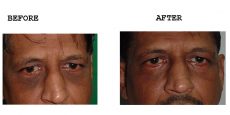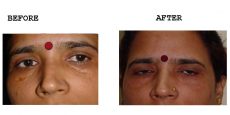Older look due to Under eye bags can be reversed very easily. Through a cut over lower eyelid herniating fat is excised & fascia defects are repaired. Then excess skin is trimmed & meticulous closure is done. Scars often fed & virtually vanish. Blepharoplasty , also known as eyelift and eyelid surgery. blepharoplasty, improves the appearance of the upper eyelids or lower eyelids
What is eyelid surgery (blepharoplasty)?
Blepharoplasty is a surgical procedure to remove excess skin, fat and/or muscle from around the eyes to correct drooping upper eyelids and lower eyelid bags. Surgery gives a rejuvenated, more rested and alert appearance to the eyes.
Blepharoplasty can be carried out under a general anaesthetic and either requires a one night stay in hospital, or in some cases, can be performed on a day case basis. Alternatively, upper blepharoplasty can be carried out under local anaesthetic on a day case or outpatient basis. Your surgeon will advise which anaesthetic is the most appropriate in your case. For surgery on the upper eyelids, an incision is made in the natural line/crease in the eyelid. For surgery on the lower eyelids, an incision is made just below the eyelash line. In both cases, the resulting scars will run along the eye’s natural folds, concealing them as much as possible. Excess skin, fat and/or muscle is removed and when surgery is complete, the incisions are closed using very fine sutures. Following the procedure you will be taken from the operating theatre into the recovery suite where you will be looked after until you are fully awake. After this, you will return to your room, where nursing staff will check your dressings and monitor your pulse and blood pressure at regular intervals. The anaesthetist will prescribe painkillers and you should take these regularly for the first week or so. Pain can slow down your recovery, so it is important to discuss any discomfort with the nursing staff. There may be a drip in one of your arms – this is to keep you well hydrated. This will be removed when you are able to drink a satisfactory amount. You will have light dressings on your eyes – usually paper stitches. A lubricating ointment may be applied to your eyes to prevent them from becoming dry. Cooling eye masks/ice packs are often used to minimise swelling.
After blepharoplasty you are likely to have some pain/discomfort, swelling and bruising. Your eyes may feel tight and difficult to close when you go to sleep. These are temporary and should subside after the first few weeks. Avoid applying eye make-up until advised by your surgeon – this is usually a few days after removal of your sutures. Contact lenses must not be worn for at least two weeks following surgery, and initially they may feel uncomfortable when you resume wearing them. You will receive a post-operative telephone call from the specialist nurse one to two days after your discharge home to ascertain your progress and well-being. You will also receive a follow-up appointment at which your surgeon will assess your progress and give advice on when you can resume your normal activities. You must avoid strenuous exercise, heavy lifting and swimming for approximately four weeks after surgery. You should only resume driving when you are confident that your vision is completely back to normal. The length of time you will need to take off work will depend on your type of employment, but is usually a minimum of one week.
Blepharoplasty is a commonly performed and generally safe procedure. However, all surgery carries an element of risk. The possible complications of any surgery can include an unexpected reaction to a general anaesthetic, excessive bleeding, infection and developing a blood clot (usually in a vein in the lower leg, known as a deep vein thrombosis). You will be left with visible scars following your surgery. Initially they will be red and slightly raised, but they should gradually soften and fade over the following months. In some cases, the eyes can feel sticky or dry and itchy for the first week or so. Occasionally the eyes can become watery and/or sensitive to light for a few weeks. Some patients can experience blurred or double vision for a few days. There is a small possibility that swelling of the lower eyelid can cause it to be pulled away from the eye – an ectropion. This usually settles on its own, but occasionally requires further surgery.



